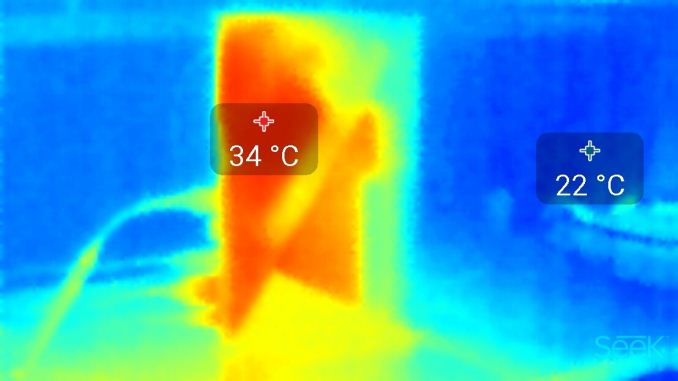The NVIDIA SHIELD Android TV Review: A Premium 4K Set Top Box
by Ganesh T S on May 28, 2015 3:00 PM EST- Posted in
- Media Streamer
- Home Theater
- TV
- 4K
- Shield
- NVIDIA
Power Consumption and Thermal Performance
In order to see what the power and thermal characteristics of the SHIELD Android TV are like, the device was tested in two scenarions:
- 1080p60 HDMI output to Pioneer VSX-32, connected to a Sony KDL46EX720 46" 1080p TV. Connected to a wired network, with a Samsung T1 SSD hanging off the USB 3.0 port
- 4Kp60 HDMI output to a Samsung HU6950 40" 4K TV. Connected to a wireless network, with a Samsung T1 SSD hanging off the USB 3.0 port.
The table below summarizes the important power consumption numbers.
| NVIDIA SHIELD Android TV Power Consumption | |
| Activity | Avg. Power (W) |
| Idle (Scenario 1) | 3.6 W |
| 1080p Netflix Streaming (Scenario 1) | 4.6 W |
| 1080p YouTube Streaming (Scenario 1) | 4.7 W |
| Kodi Playback (Hardware Accelerated 1080p60 H.264) (Scenario 1) | 6.5 W |
| Kodi Playback (Software Decoding 1080i60 VC-1) (Scenario 1) | 10.4 W |
| Idle (Scenario 2) | 4.2 W |
| 4K HEVC Playback (Scenario 2) | 9.1 W |
| 4K Netflix Streaming (Scenario 2) | 10.3 W |
| Gaming (Scenario 2) | 19.4 W |
Since the gaming scenarios stressed the at-wall power consumption heavily, we decided to run the GFXBench battery life test which puts the T-Rex benchmark in an infinite loop. After 2 hours, we took a thermal image of the unit (oriented vertically with the SHIELD stand).
The thermal solution is excellent, and the frame rates were consistent across all the benchmark runs. Thanks to the low-power SoC, the chassis temperature was just 34 C (ambient at 23 C). The fan noise was audible only when we kept our ears against the vents in the back panel.
Moving on to the business end of the review, we split up the positives and negatives into two sections - one for Android TV itself, and the other for the SHIELD.











167 Comments
View All Comments
Ryan Smith - Thursday, May 28, 2015 - link
It's a matter of time in covering everything, along with the fact that GameStream is not a new technology in the ecosystem. Once the commercial GRID service launches, we'll be taking a more focused look at gaming on the SHIELD.Sonicadvance1 - Thursday, May 28, 2015 - link
Hello. Dolphin emulator developer here.I've had an Nvidia SHIELD Android TV in my hands for a while now.
I'd like to clarify in my comment the CPU and GPU speeds on this device
The Cortex-A57s max clock speed is 2.01Ghz, and the Maxwell GPU's max clock speed is 998Mhz.
I haven't checked the Cortex-A53's max clock speeds because being a Dolphin developer I effectively don't care about them.
jjj - Thursday, May 28, 2015 - link
Got to wonder if it wouldn't be more appealing as a Linux PC or even a Chromebox. In those segments the pricing wouldn't be as unreasonable.funtasticguy - Friday, May 29, 2015 - link
Sonicadvance1, how does the Dolphin emulator work on this? What kind of speed improvement does this offer compared to the Tegra K1?Sonicadvance1 - Friday, May 29, 2015 - link
It runs the new AArch64(ARMv8) JIT recompiler for the CPU core, which lets it run a few games full speed. This new core will take a long while to become fully optimized, but I'm taking steps to make it easier to profile the code's performance from Android which will help in the future.This new CPU core is going to be more maintainable than the old 32bit ARMv7 CPU core.
funtasticguy - Friday, May 29, 2015 - link
Thanks for your reply!Wardrive2015 - Friday, May 29, 2015 - link
Thank you Sonicadvance1 for the clarification on the clocks. Would you say single threaded performance is roughly equal to that of Denver?Sonicadvance1 - Friday, May 29, 2015 - link
It's about on par, slightly better in some cases.Due to the Denver's quirky architecture the A57s will be quicker than the Denver in code that only executes a few times. This is due to the Denver only recompiling code to native VLIW if it has been called a certain number of times(This number is undisclosed).
For code that executes over and over the two CPUs are about on par with each ones winning depending on the situation.
Haydon987 - Thursday, May 28, 2015 - link
The big question is, can it do HDMI 2.0 with HDCP 2.2 at 4:4:4 all at the same time? Last I heard, no HDCP decoding chip currently in existence does this.They all downgrade to 4:2:0 when playing protected content and can only do 4:4:4 when playing unprotected content, which is about nothing other than gaming.
Haydon987 - Thursday, May 28, 2015 - link
At 4K, I should add.